Original URL: https://www.theregister.com/2013/05/10/game_theory_may_releases_roundup/
Fighting Fantasy and fantastic fights in tights
Steve Jackson’s Sorcery!, Injustice - Gods Among Us and more
Posted in Personal Tech, 10th May 2013 09:04 GMT
Game Theory This month’s column has been unceremoniously cleft in twain. Why? Because, while May’s big news will undoubtedly revolve around Microsoft’s unveiling of its Xbox 360 successor, there are still a fine number of new releases to discuss.
Expect the second part of this month’s Games Theory right after the dust has settled on all things Xbox. For now, take a look at three of the games that have been taking up my time in the past couple of weeks.
Steve Jackson’s Sorcery! - Fighting Fantasy rolls on
“A large troll assails you, swinging a log the size of a tree trunk straight at your heroic face. Test your luck. Turn to 358 if you pass, or 79 if you failed...”
If the previous paragraph brings back rose-tinted memories of sharpened pencils, hastily scribbled notes and having your nose buried in a book that your mother would never have approved of, then chances are you were a fan of Steve Jackson and Ian Livingstone’s Fighting Fantasy books.
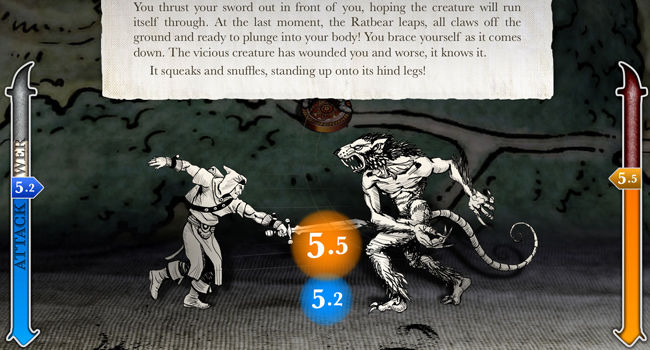
Put him on dice
The likes of The Warlock of Firetop Mountain, Deathtrap Dungeon and, indeed, Steve Jackson’s Sorcery! were manna from heaven for adolescent boys seeking escapist thrills in the pre-internet era. Now, interactive book specialist Inkle has taken Sorcery! and crafted a textual adventure that feels delightfully true to the original.
Gone is the habitual Fighting Fantasy pre-rolling for initial scores of stamina, luck and skill, with such statistical calculations all being quietly number-crunched in the background. There’s also no need to bring a pencil along on the journey, with your device tracking your stats and items for you, and even displaying a map of the kingdom of Kakhabad upon which you plot your route.
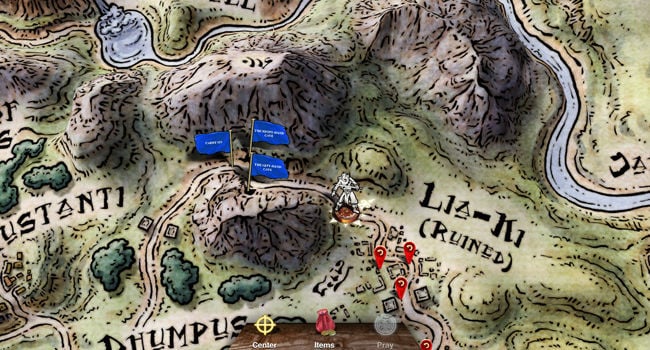
Better than graph-paper and pencil?
Sorcery! even offers you a get-out clause by allowing the repeating of previously explored areas. Therefore you might rewind an ultimately deadly decision to turn left, instead bearing right, albeit at the cost of anything gathered on your original endeavour.
Combat can be similarly replayed, which is just as well, for fighting the game’s many beasts is quite the challenge. That’s in no small part down to a combat system which incorporates equal shares of skill and luck in a nod to its paperback forebear.
It works like this: you have a certain number of attack points per turn, as does your opponent. From those you can opt for any strength of attack, from a full-on charge to a more defensive stance. Your adversary will do likewise, and whoever committed the most points to the attack will land the damaging blow.
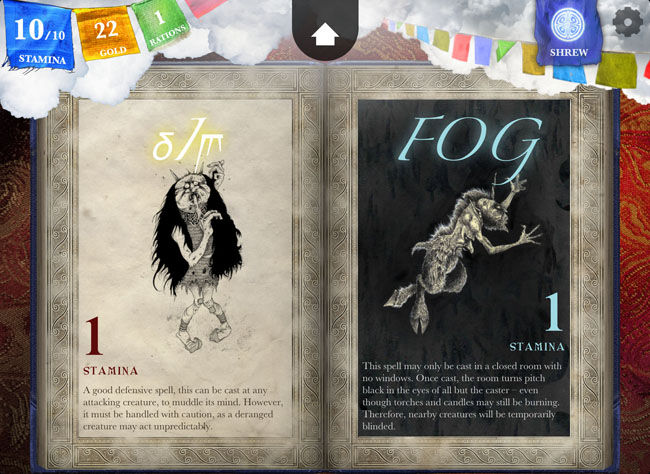
Spell checker
The strategy - and luck - comes into play on subsequent rounds, however, as only a portion of your initial attack points will regenerate, therefore making it pertinent to commit as few points per turn as possible. Too few, though, and it’s you who’ll be propping up the daisies of the Shamutanti Hills.
’If you chose ’gold’, turn to 400’
Beyond combat, most interaction comes through making choices during play. Will you search the troll’s empty lair? If yes, will you search the table, the floor, or the beast’s bed? Will you search all of them and risk the troll’s return - or will you wait for the troll anyway in order to ambush it? You might even choose to cast a spell to improve your chances, though at the cost of stamina. Decisions, decisions...
There’s no denying I had fun with Sorcery!. It brought back fond memories of imaginary adventures past, and zips by at a fine fettle due to its nicely worked interface. My only real complaints are that battles can rely on a tad too much luck and that the game is on the brief side.
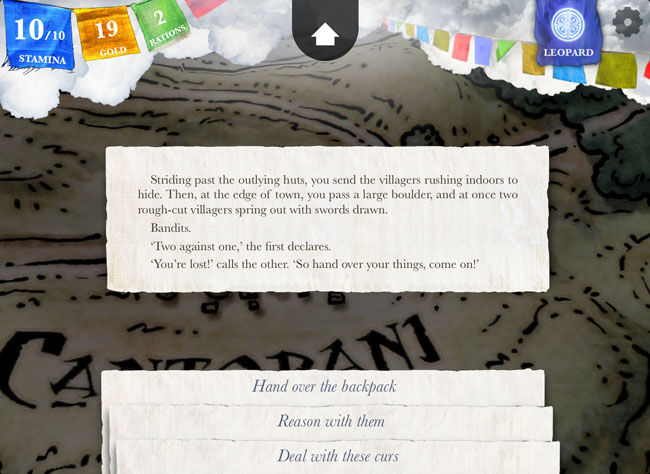
Decisions, decisions...
But there’s plenty of scope for replays, and going round again is encouraged by a narrative system that adjusts to your current condition and circumstances. That said, a single play-through of this first episode will take just a few hours to complete.
Some of the descriptive writing could be stronger too. The prose is no better or worse than the Fighting Fantasy series of old, but back then I was ten. I’m now in my Game of Thrones-consuming thirties, and so expect a higher standard of prose. Still, at least there’s no temptation to turn straight to page 400 in order to read the ending - or, rather, such will be the case once Sorcery! gets its concluding chapters: Kharé - Cityport of Traps, The Seven Serpents and The Crown of Kings.
Criticisms aside, the adventure was novel enough to keep me invested right up until part one’s conclusion, has a good amount of replay value and, at £2.99, this iOS-based game is easy enough on the wallet to allow for my whole-hearted recommendation.
![]()
Injustice: Gods Among Us - It was a dark and stormy knight...
Injustice’s plot is essentially a treatise of what might happen should all-American hero Superman finally grow a pair and decide to truly flex his solar-powered Kryptonian muscles against wrong-doers, superhuman or otherwise, once and for all.
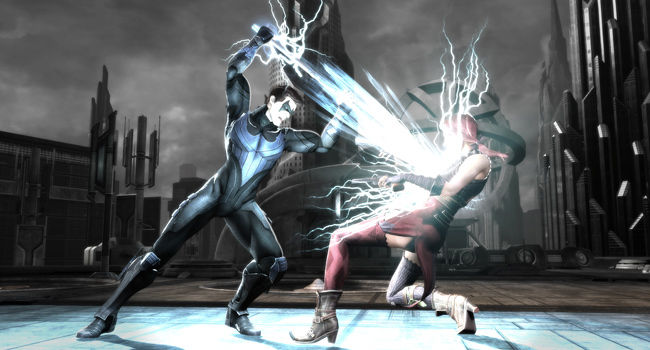
Zap-'em-up
I won’t ruin the whys and wherefores of how such a state of affairs comes about here – though it will be of little surprise to anyone to hear that Joker is heavily involved. All that really matters is the outcome, which leaves Batman in the role of underground resistance leader as the Man of Steel goes about his despotic work.
This scenario paves the way for a multi-platform 2D brawler very much in the mould of NetherRealm Studios’ 2011 Mortal Kombat reboot. The game places similar emphasis on a story driven campaign which incorporates a whole roster of fighters, and shifts the player quickly from character to character.
Combatants consist of the mainstay of the Justice League, with the majority of DC’s big-name bad guys thrown in for good measure. Each comes with signature moves straight out of the comics: heat vision, bat gadgets, acid spewing flowers, bullet deflecting bracelets - you name it, it’s in there.
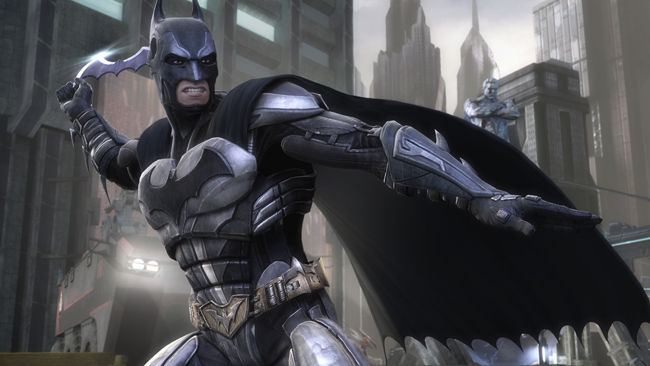
Simon cowl
The question of the characters’ relative power grades is largely glazed over by the invention of a lazy catch-all pill that magically boosts the merely human cast to superhuman levels. That still doesn’t explain why Superman doesn’t simply throw the human protagonists into the cold depths of space. But hey, let’s suspend disbelief shall we?
Man of steel, woman of Kleenex
This being a fighting game, its quality must ultimately be judged by its moves and combos. It’s here where I’m left short of any real praise, for clunky move sets lacking in flow and finesse disappoint. Yes, heroes and villains look the part but rarely does an encounter play as you’d expect.
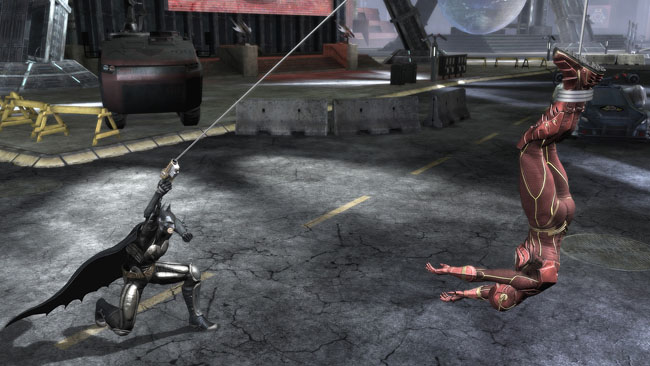
Tie me up, tie me down
Truly ‘super’ characters are never able to cut loose. Since when would Superman ever keep himself grounded for the vast majority of a fight? While the idea of Harley Quinn or Joker tackling Green Lantern - or worse, Superman - head-on, despite the aforementioned power-balancing pills, is plain ludicrous.
A ubiquitous energy charging system lets you perform extra powerful moves, or unleash your character’s time-sapping special. There’s also a wide assortment of blocking options and chances to interact with the scenery. Inevitably, however, there’s too much taken over from Mortal Kombat, meaning that characters never feel as supple as those of Street Fighter, for example.
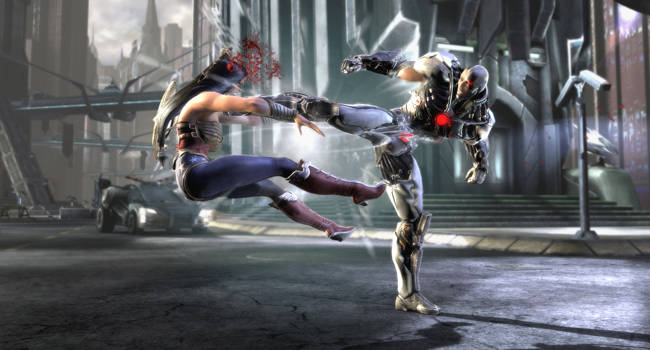
Get your kicks
Fans of comics, and particularly DC, will no doubt forgive the stiff fighting, while Mortal Kombat devotees should be well served too. However, beat-’em-up stalwarts might be best advised to give this the swerve, for it adds little new to the genre beyond the fireworks provided by some well-known men in capes and spandex.
![]()
The Cat Lady - the daily horror scope
R Michalski’s PC-based The Cat Lady will make your brain hurt and it’ll play with your sub-conscience until you have to take a peek over your shoulder just to make sure that no one’s there.
That’s because the game is pure malevolence in the best possible way. It explores human darkness, depression, claustrophobia and isolation to a degree that few games have dared before. That it generates such atmosphere without resorting to cheap scare tactics is all the more impressive, and mainly attributable to it being a slow-moving point-and-click adventure.
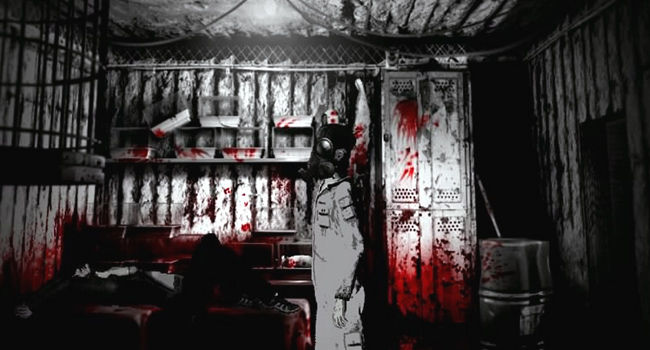
There will be blood
The story follows the suicidal Susan Ashworth, who’ll soon find herself confronted by the tellingly titled “Queen of Maggots”. Soon thereafter, with soul dirtied and blood spilt, Susan finds herself in pursuit of five “parasites” – psychopaths by any other name – who she must destroy to accomplish... well, that’s the question isn’t it? What does a suicidal person actually want?
Confused? You will be, but The Cat Lady’s staccato plot, interwoven with moments of pure horror is captivating in its eeriness. It’s gaming’s equivalent of someone scratching their nails across a blackboard and is brave enough to not care about offending the conscientious out there. Its minimalist graphic style will strike a chord with anyone who has read any of Ben Templesmith’s bleaker works.
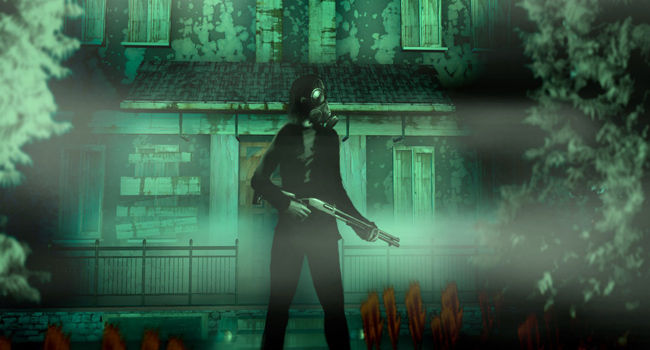
Point‘n‘shoot
There are short comings of course, with some dialogue neither written nor delivered with as much panache as you might hope. Then there’s the familiar try everything with everything approach to puzzles endemic of the genre. But all of that can forgiven when you consider its indie origins and price.
With this and Kentucky Route Zero both recently released, and The Walking Dead famously shuffling its undead stuff last year, it seems we’re entering something of a new golden era for the graphic adventure game genre and long may it continue. ®
![]()